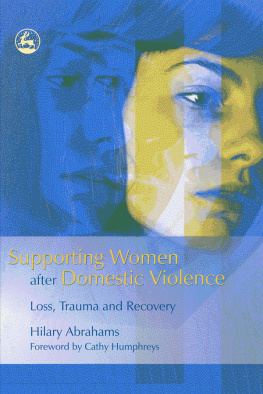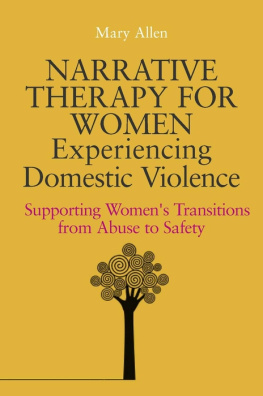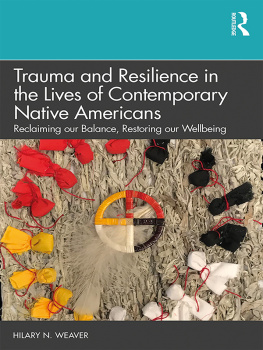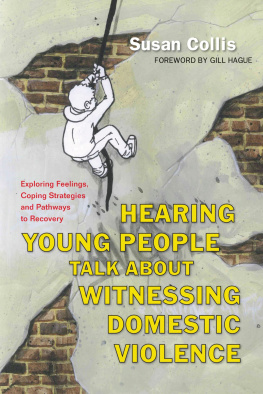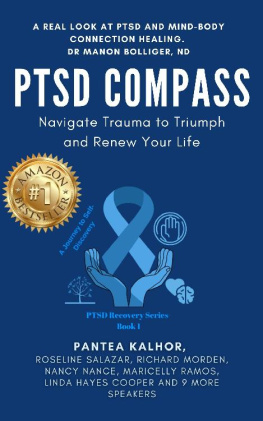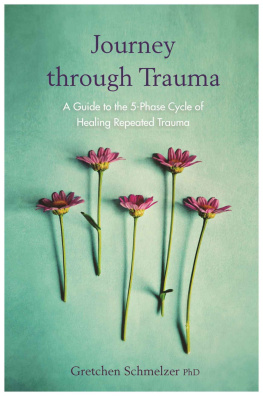Hilary Abrahams - Supporting Women After Domestic Violence: Loss, Trauma and Recovery
Here you can read online Hilary Abrahams - Supporting Women After Domestic Violence: Loss, Trauma and Recovery full text of the book (entire story) in english for free. Download pdf and epub, get meaning, cover and reviews about this ebook. publisher: Jessica Kingsley Publishers, genre: Home and family. Description of the work, (preface) as well as reviews are available. Best literature library LitArk.com created for fans of good reading and offers a wide selection of genres:
Romance novel
Science fiction
Adventure
Detective
Science
History
Home and family
Prose
Art
Politics
Computer
Non-fiction
Religion
Business
Children
Humor
Choose a favorite category and find really read worthwhile books. Enjoy immersion in the world of imagination, feel the emotions of the characters or learn something new for yourself, make an fascinating discovery.
- Book:Supporting Women After Domestic Violence: Loss, Trauma and Recovery
- Author:
- Publisher:Jessica Kingsley Publishers
- Genre:
- Rating:5 / 5
- Favourites:Add to favourites
- Your mark:
- 100
- 1
- 2
- 3
- 4
- 5
Supporting Women After Domestic Violence: Loss, Trauma and Recovery: summary, description and annotation
We offer to read an annotation, description, summary or preface (depends on what the author of the book "Supporting Women After Domestic Violence: Loss, Trauma and Recovery" wrote himself). If you haven't found the necessary information about the book — write in the comments, we will try to find it.
Hilary Abrahams: author's other books
Who wrote Supporting Women After Domestic Violence: Loss, Trauma and Recovery? Find out the surname, the name of the author of the book and a list of all author's works by series.
Supporting Women After Domestic Violence: Loss, Trauma and Recovery — read online for free the complete book (whole text) full work
Below is the text of the book, divided by pages. System saving the place of the last page read, allows you to conveniently read the book "Supporting Women After Domestic Violence: Loss, Trauma and Recovery" online for free, without having to search again every time where you left off. Put a bookmark, and you can go to the page where you finished reading at any time.
Font size:
Interval:
Bookmark:
of related interest
Picking up the Pieces After Domestic Violence
A Practical Resource for Supporting Parenting Skills
Kate Iwi and Chris Newman
ISBN 978 1 84905 0210
eISBN 978 0 85700 533 5
Narrative Therapy for Women Experiencing Domestic Violence
Supporting Womens Transitions from Abuse to Safety
Mary Allen
ISBN 978 1 84905 190 3
eISBN 978 0 85700 420 8
Making an Impact
Children and Domestic Violence - A Reader
2nd edition
Marianne Hester, Chris Pearson and Nicola Harwin with Hilary Abrahams
ISBN 978 1 84310 157 4
eISBN 978 1 84642 584 4
Domestic Violence and Child Protection
Directions for Good Practice
Edited by Cathy Humphreys and Nicky Stanley
ISBN 978 1 84310 276 2
eISBN 978 1 84642 476 2
Talking about Domestic Abuse
A Photo Activity Workbook to Develop Communication between Mothers and Young People
Cathy Humphreys, Ravi K. Thiara, Agnes Skamballis and Audrey Mullender
ISBN 978 1 84310 423 0
eISBN 978 184642 533 2
Talking to My Mum
A Picture Workbook for Workers, Mothers and Children Affected by Domestic Abuse
Cathy Humphreys, Ravi K. Thiara, Agnes Skamballis and Audrey Mullender
ISBN 978 1 84310 422 3
eISBN 978 1 84642 526 4
Mothering Through Domestic Violence
Lorraine Radford and Marianne Hester
ISBN 978 1 84310 473 5
eISBN 978 1 84642 539 4
Child Protection, Domestic Violence and Parental Substance Misuse
Family Experiences and Effective Practice
Hedy Cleaver, Don Nicholson, Sukey Tarr and Deborah Cleaver
ISBN 978 1 84310 582 4
eISBN 978 1 84642 673 5
Supporting Women after Domestic Violence
Loss, Trauma and Recovery
Hilary Abrahams
Foreword by Cathy Humphreys

Jessica Kingsley Publishers
London and Philadelphia
First published in 2007
by Jessica Kingsley Publishers
73 Collier Street
London N1 9BE, UK
and
400 Market Street, Suite 400
Philadelphia, PA 19106, USA
www.jkp.com
Copyright Hilary Abrahams 2007
Foreword copyright Cathy Humphreys 2007
All rights reserved. No part of this publication may be reproduced in any material form (including photocopying or storing it in any medium by electronic means and whether or not transiently or incidentally to some other use of this publication) without the written permission of the copyright owner except in accordance with the provisions of the Copyright, Designs and Patents Act 1988 or under the terms of a licence issued by the Copyright Licensing Agency Ltd, Saffron House, 6-10 Kirby Street, London EC1N 8TS. Applications for the copyright owners written permission to reproduce any part of this publication should be addressed to the publisher.
Warning: The doing of an unauthorised act in relation to a copyright work may result in both a civil claim for damages and criminal prosecution.
Library of Congress Cataloging in Publication Data
A CIP catalog record for this book is available from the Library of Congress
British Library Cataloguing in Publication Data
A CIP catalogue record for this book is available from the British Library
ISBN 978 1 84310 431 5
eISBN 978 1 84642 615 5
In memory of my mother, Dorothy,
for whom there was never any refuge
This book was made possible through the interest, involvement and support of many women. My thanks go to:
the residents and former residents of Penzance, Birmingham and York Womens Aid refuges, who were willing to share their experiences and thoughts to establish a better understanding of their issues and support needs and to help other women
the workers, volunteer staff and management at the refuges who took time out of their busy lives to explain, advise, discuss and comment
all the members of Womens Aid who have helped in shaping the research on which this book is based with their ideas, comments and feedback
my advisors, Ellen Malos and Nicola Harwin, and my support group, especially Emma, Judith, Louise and Mandy
and finally to Ian, for his unfailing support and encouragement.
List of Figures and Tables
Figures
Table
Domestic violence corrodes the fabric of womens emotional and social worlds. The process of extinguishing a womans sense of herself, her relationships, her understanding of her past and her present is a destructive one. It occurs behind closed doors and thrives in an environment of secrecy and isolation. Unsurprisingly, others, including professionals have had little access to this closed world and its destructive interior.
Paradoxically, the route to safety has also, and by necessity, often occurred behind closed doors. There has been little exposure of the complex process of support and healing which has been undertaken with workers and other women within the refuge sector. The need for secret addresses, high levels of security, and privacy to allow the slow process of recovery has meant that the work of refuges has also been subject to invisibility.
This book brings to light the complexity of this work and womens journeys. It is not before time. The context of womens services is changing. The entwining of advocacy for services combined with the high levels of emotional support required for women to embark on the difficult pathway to recovery is changing and not always for the best. A number of challenges beset both individual women and the sector.
Firstly, the drive to provide cheaper and more efficient accommodation for women and children escaping domestic violence has frequently meant that the complex array of services provided through refuges has been underestimated. The threat to specialist refuges for black and minority ethnic women, and the drive to provide only minimal support through hostel accommodation fails to recognise the level of fear, trauma and grief which the crisis of separation can represent. It is not a time to leave women alone to fend for themselves when this act of independence and bravery can provide the first step towards a new life free from violence. High level support is essential and cost effective and should not be constructed as a luxury. This book provides a graphic reminder that this is the case.
The second issue lies in contrast, and possibly contradiction to the first. This is namely that domestic violence intervention is becoming increasingly professionalised. Domestic violence forums are dominated by police, health professionals, social workers and housing workers. While this mainstreaming is an exciting development which can create significantly more attention to domestic violence, it carries with it some dangers. These can include downgrading the high levels of competence and experience provided by Womens Aid and other specialist voluntary sector organisations, as well as an underestimation of the role and value of mutual support provided by one survivor towards another and the effectiveness of creating shared activities for children.
Understanding the balance to be struck is particularly evident when the intervention to support the emotional well-being of both women and children is considered. Recognition that the impact of violence and abuse can be traumatising and that the erosion of womens esteem and identity can lead to depression, high anxiety and suicide attempts is not new. However, problems arise if we then think that only professional counsellors and mental health professionals are able to provide the requisite help. Again, this book provides an important reminder that mutual support should be considered a central rather than a peripheral aspect of the healing journey for many women. The interviews with women in refuges provide testimony to its significance and a reminder that as the purpose built refuge characterised by separate accommodation units for women and children emerges, that steps are required by workers to facilitate the opportunities for women to get to know and support each other in their day- to-day living. A major step in the recovery from trauma and hence recovery in the aftermath of violence is to re-establish social support and step away from the isolation created by violence and abuse.
Font size:
Interval:
Bookmark:
Similar books «Supporting Women After Domestic Violence: Loss, Trauma and Recovery»
Look at similar books to Supporting Women After Domestic Violence: Loss, Trauma and Recovery. We have selected literature similar in name and meaning in the hope of providing readers with more options to find new, interesting, not yet read works.
Discussion, reviews of the book Supporting Women After Domestic Violence: Loss, Trauma and Recovery and just readers' own opinions. Leave your comments, write what you think about the work, its meaning or the main characters. Specify what exactly you liked and what you didn't like, and why you think so.

